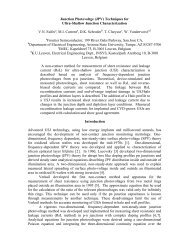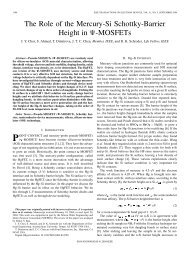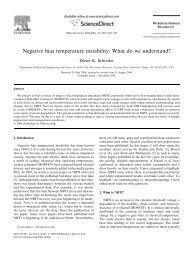ECS Transactions 3, (4), 321-337 (2006) - Dieter Schroder - Arizona ...
ECS Transactions 3, (4), 321-337 (2006) - Dieter Schroder - Arizona ...
ECS Transactions 3, (4), 321-337 (2006) - Dieter Schroder - Arizona ...
Create successful ePaper yourself
Turn your PDF publications into a flip-book with our unique Google optimized e-Paper software.
<strong>ECS</strong> <strong>Transactions</strong> 3, (4), <strong>321</strong>-<strong>337</strong> (<strong>2006</strong>)<br />
substrate. Many wafers were sampled, of which Fig. 8 is one sample. The mapping patterns<br />
on the substrates were substantially different from one wafer to another, although<br />
they all exhibited concentric patterns, due to the oxygen precipitation striation in the<br />
Czochralski-grown Si crystals. The dark spots in Fig. 8(a) are due to bonding defects.<br />
(a)<br />
(b)<br />
Figure 8. 200 mm bonded SOI wafer. (a) UV excitation samples the Si film, (b) visible<br />
excitation samples the substrate. Maps courtesy of M. Tajima, Institute of Space and Astronautical<br />
Science, Japan.<br />
Optical Beam-Induced Resistance Change (OBIRCH)<br />
The optical beam-induced resistance change method has become an important failure<br />
analysis technique for integrated circuits. The chip under investigation is powered by applying<br />
the appropriate chip voltage and then it is scanned with all lines electrically active.<br />
Some of the laser energy is converted into heat leading to a temperature rise in the lines.<br />
The temperature coefficient of resistance (TCR) of metals is usually positive, so that a<br />
temperature increase leads to a line resistance increase and a current decrease, illustrated<br />
in Fig. 9(a).<br />
IR Laser<br />
TV<br />
Display<br />
I<br />
I ± ∆I<br />
Figure 9. OBIRCH (a) schematic showing the incident laser from either top or bottom<br />
and the current change, (b) uniform metal line in dark with a defect ion the bright contrast<br />
area. After Nikawa ref. 22.<br />
For constant voltage, the current change (∆I) due to the laser heating is approximately<br />
proportional to the resistance change (∆R), which is proportional to the temperature increase<br />
(∆T). 20 When the laser beam scans, the heat is transmitted freely across defect-free<br />
areas, but heat transmission is impeded when the beam encounters defects, such as voids<br />
and Si nodules, creating differences in temperature increases between irradiated points<br />
328








